Alabama is a state in the southeast with a diverse ecosystem. You can find everything from forests to coastlines to swamps and marshes. These environments provide excellent homes for birds of many species. Discover 12 blue birds in Alabama and learn about their habitats, foraging behavior, and how to attract them to your feeder.
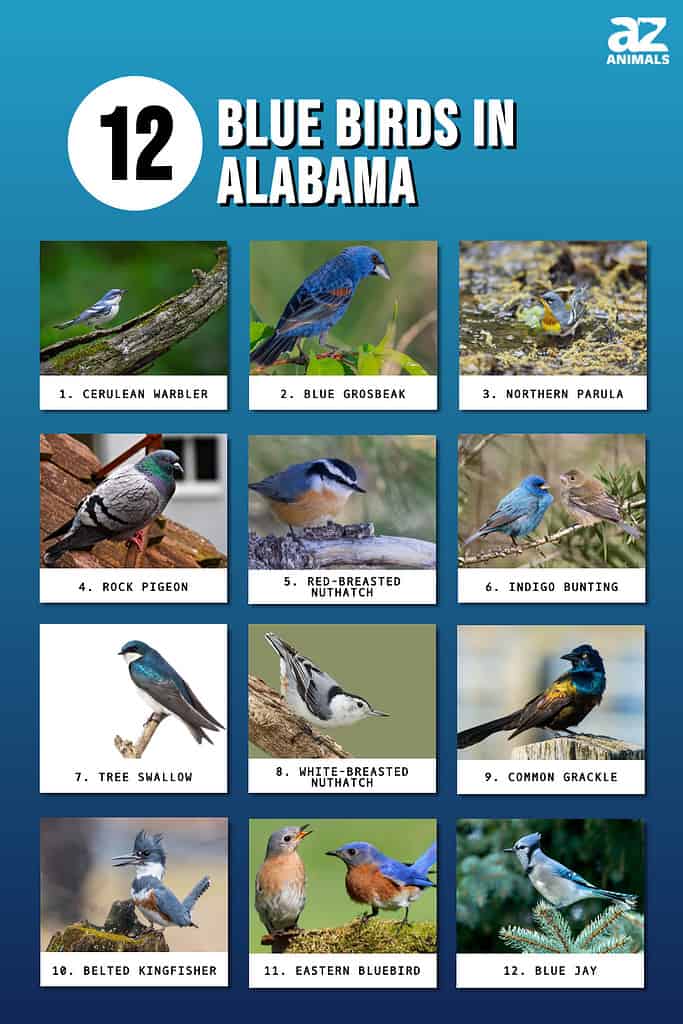
1. Cerulean Warbler

Cerulean warblers search for insects high in the trees and catch their prey mid-air.
©iStock.com/ps50ace
Habitat and Range: The cerulean warbler is a common migrant through Alabama. They breed in the northeast before making their long journey to South America. During migration, they stop in scrub habitats.
Coloring: They come in sky blue, white, and black.
Calls: Their calls are short buzzy notes and metallic “zeets.”
Diet and Foraging: Cerulean warblers eat insects and search for food high in the trees, swooping out to catch prey mid-air. You may see them in groups during migration and winter.
Backyard Tip: They do not visit feeders.
2. Blue Grosbeak
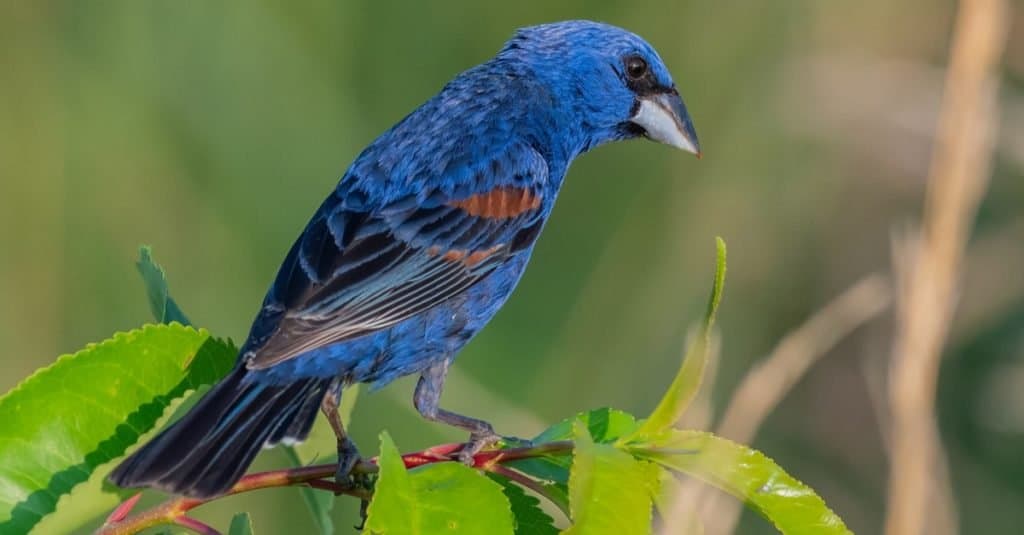
Blue grosbeaks breed throughout Alabama, where they inhabit dense low-growth areas.
©Jim Beers/Shutterstock.com
Habitat and Range: Blue grosbeaks breed throughout the Southern United States, which includes Alabama. These birds live in the state during the spring and summer in dense low-growth areas, such as brushy fields, second-growth, and woodland edges.
Coloring: Vibrant blue, chestnut, silver, and black form their color palette.
Calls: They make rich warbles and metallic calls.
Diet and Foraging: They primarily eat seeds and insects and forage on the ground or in low vegetation. They occasionally hover while capturing insects.
Backyard Tip: Place suet, peanuts, and sunflower seeds in a feeder to attract blue grosbeaks.
3. Northern Parula
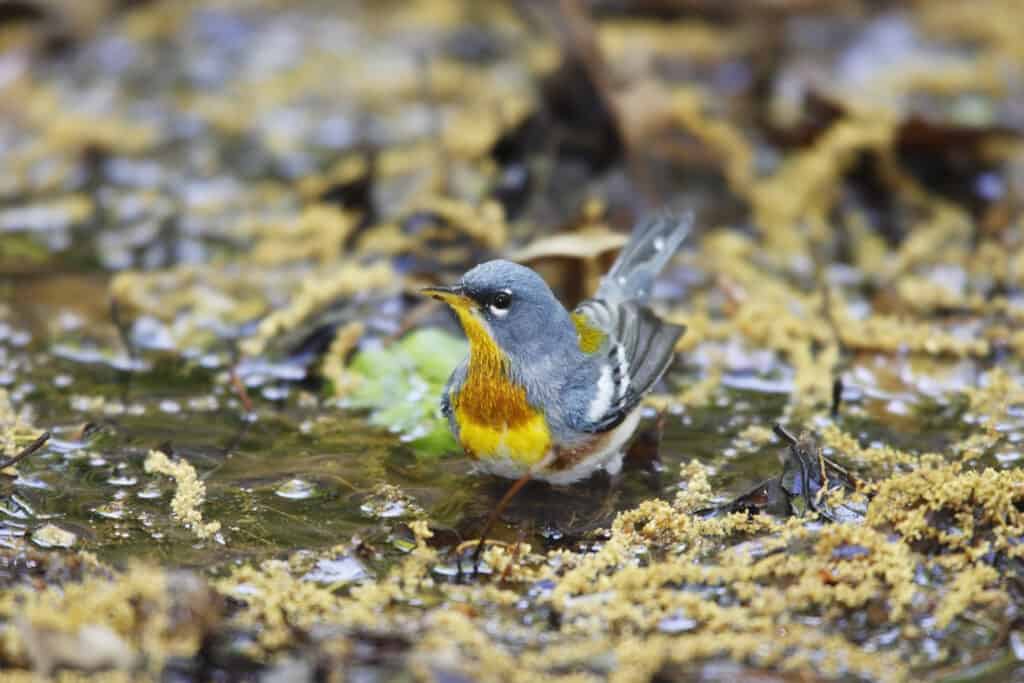
Northern parulas are relatively solitary while breeding but will join mixed-species flocks during migration.
©Stubblefield Photography/Shutterstock.com
Habitat and Range: The northern parula is a breeding bird of the Eastern United States. You can spot them and their nests in Alabama during summer. Look for them in humid woods with hanging Spanish moss.
Coloring: They are bluish-gray, chestnut, yellow, white, and black.
Calls: Listen for their buzzy trills and sharp chirps.
Diet and Foraging: These insectivores forage slowly among leaves, hovering or hanging upside down to capture prey.
Backyard Tip: The northern parula does not visit feeders. You may attract them if you plant shrubs and trees.
4. Rock Pigeon
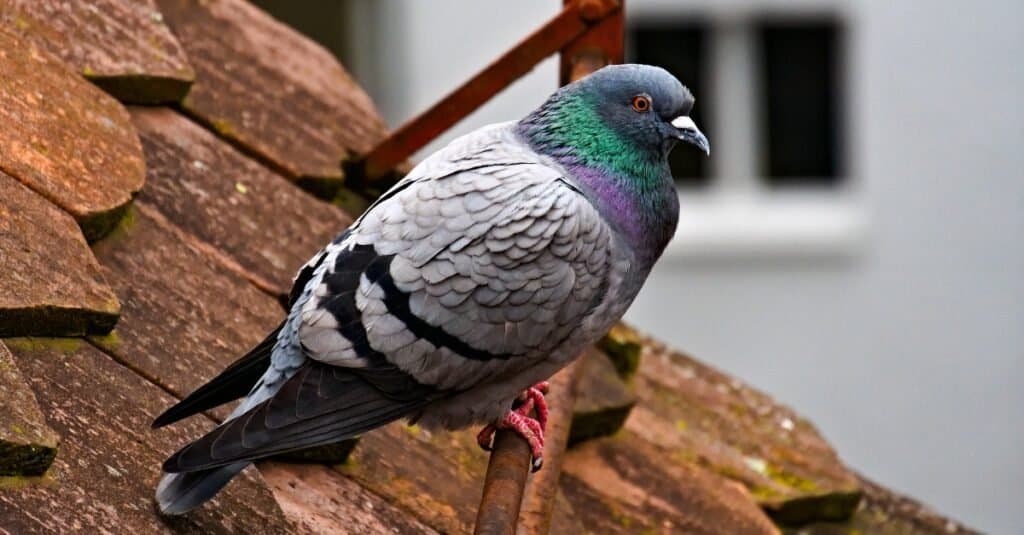
Rock pigeons are abundant all year in Alabama near cities, suburbs, and farms.
©iStock.com/Christian Sturzenegger
Habitat and Range: Rock pigeons are abundant in the United States and most of North America. You will find them throughout the year in Alabama and the rest of the country. They are common around cities, suburban areas, farms, and coastal cliffs.
Coloring: They are a mix of bluish-gray, green, purple, light gray, and white.
Calls: Throaty coos and short grunts are the sounds they make.
Diet and Foraging: They primarily eat seeds. But occasionally, they will also consume berries, insects, and human trash. They forage by walking on the ground in large to small flocks.
Backyard Tip: Spread seeds or grain on the ground. Bread is not recommended as it has no nutritional value for birds.
5. Red-Breasted Nuthatch
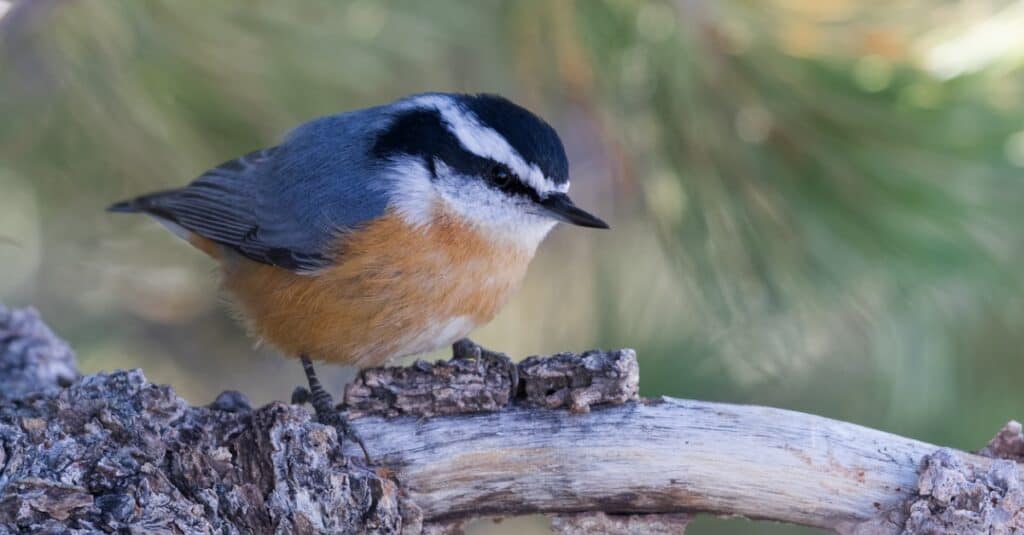
Red-breasted nuthatches spend their winter in Alabama living in coniferous forests or other wooded habitats.
©iStock.com/M. Leonard Photography
Habitat and Range: Another abundant bird in North America, the red-breasted nuthatch spends its winters across the United States, including Alabama. They prefer coniferous forests but will choose whatever wooded habitat is available during winter.
Coloring: Their shades are bluish-gray, white, black, and rusty red.
Calls: Their calls are described as fast, nasal “yank” notes.
Diet and Foraging: They eat seeds and insects and forage by climbing around trunks and sturdy limbs. They may also catch flying insects mid-air.
Backyard Tip: Red-breasted nuthatches enjoy bird baths and sunflower seeds. To attract them, limit your use of pesticides.
6. Indigo Bunting
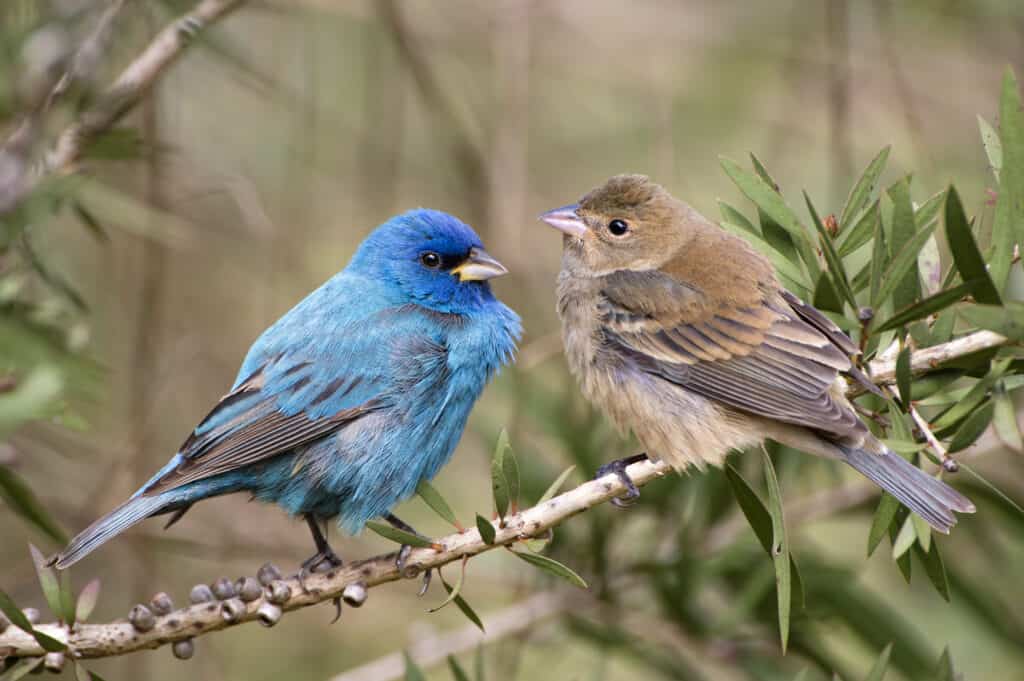
The indigo bunting breeds in Alabama near roadsides, old fields, and wood edges.
©Bonnie Taylor Barry/Shutterstock.com
Habitat and Range: Indigo buntings mainly breed in the eastern half of the U.S. You will find this species in Alabama during summer and spring, where they stay near roadsides, old fields, and woodland edges.
Coloring: They feature shades of sky blue, royal blue, silver, and black.
Calls: They emit bright, high-pitched songs and short chips.
Diet and Foraging: They eat seeds, insects, and berries. They forage alone on the ground, in shrubs, or trees.
Backyard Tip: Give them small seeds such as nyger and thistle.
7. Tree Swallow
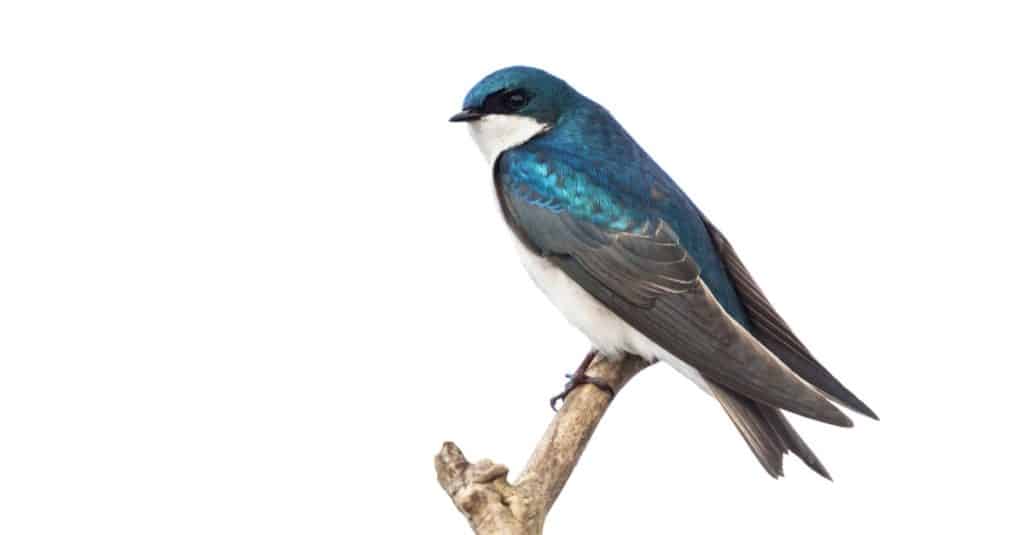
Tree swallows migrate through the state to get to the Gulf of Mexico during winter. Spot them in fields, swamps, and ponds.
©Feng Yu/Shutterstock.com
Habitat and Range: The tree swallow is a common migrant through Alabama as it makes its way to the Gulf of Mexico for winter. You are most likely to find these birds in fields, shores, swamps, marshes, and ponds.
Coloring: They are bluish-green, white, and brownish black.
Calls: Listen for high-pitched chirps, whines, and giggles.
Diet and Foraging: They perch in bushes to pluck berries, or they fly low to the ground, snatching insects mid-air.
Backyard Tip: Swallows like moving water, so place a bird bath with a fountain in your yard.
8. White-Breasted Nuthatch
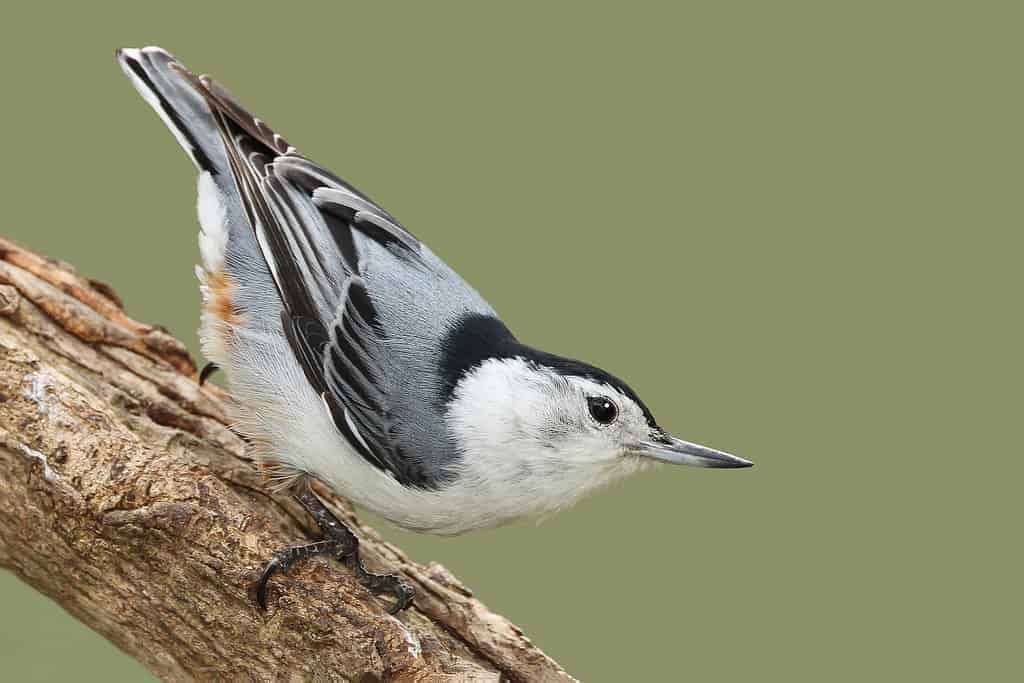
White-breasted nuthatches stay in Alabama throughout the year, but are absent from the far south.
©Brian Lasenby/Shutterstock.com
Habitat and Range: The white-breasted nuthatch lives year-round in Alabama. But they are absent in the far southern region near the coast. These birds live in most wooded areas, including mature deciduous forests, woodland edges, groves, suburbs, and parks.
Coloring: Coloring is bluish-gray, white, black, and chestnut.
Calls: Like the red-breasted nuthatch, this species has loud, nasal “yank” notes.
Diet and Foraging: They eat seeds and insects, busily moving up and down tree trunks searching for food.
Backyard Tip: These common feeder birds like suet, sunflower seeds, and peanuts.
9. Common Grackle
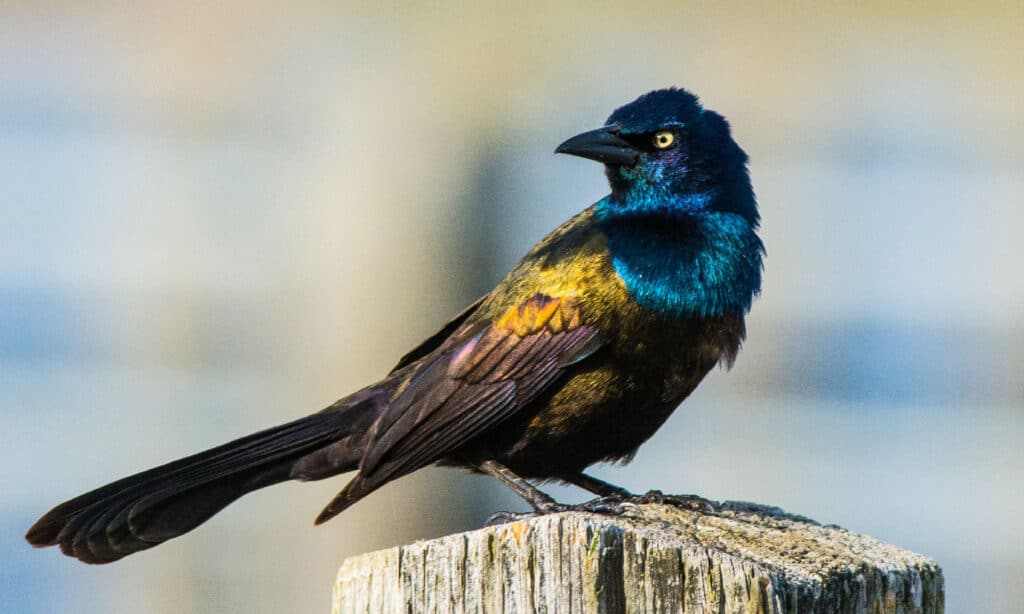
Common grackles are abundant in Alabama all year. They live in farms, towns, pastures, and lawns.
©JoshCW Photo/Shutterstock.com
Habitat and Range: The common grackle is abundant across the Eastern United States, including Alabama, where it lives year-round. They live in familiar areas, such as farms, towns, streamsides, pastures, and suburban lawns.
Coloring: They have pretty blue-green, bronze, and purple feathers.
Calls: Common grackles emit harsh squeaks, whistles, and croaks.
Diet and Foraging: They eat insects, fish, frogs, lizards, eggs, berries, seeds, and grains. They forage by walking on the ground or standing in shallow water.
Backyard Tip: Spread mixed grains and seeds on the ground to attract them to your yard.
10. Belted Kingfisher
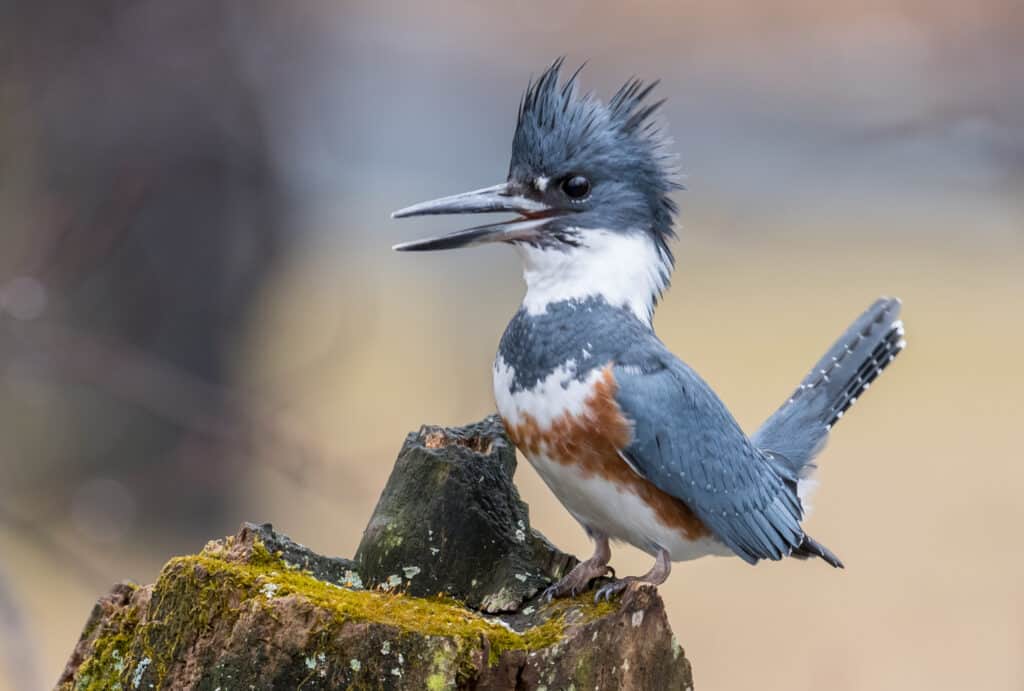
Belted kingfishers inhabit any water habitat, such as streams, lakes, rivers, marshes, and coasts.
©Harry Collins Photography/Shutterstock.com
Habitat and Range: The belted kingfisher is another prolific species of North America. You will find them year-round in Alabama and most of the United States. They live in almost any water habitat, including streams, ponds, rivers, lakes, marshes, and coasts.
Coloring: They display bluish-gray, white, and chestnut plumage.
Calls: Mechanical rattles and harsh screams are their calling cards.
Diet and Foraging: They mainly eat small fish, but will occasionally consume frogs, insects, small mammals, lizards, berries, and young birds. They catch prey by plunging their beaks into the water.
Backyard Tip: They will not visit your backyard unless you have a pond, stream, or other body of water.
11. Eastern Bluebird
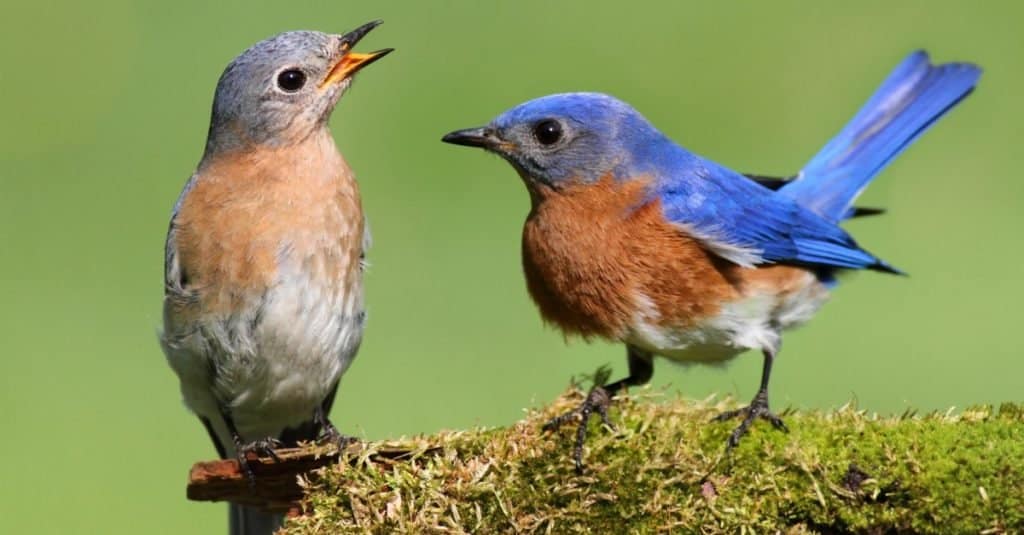
The eastern bluebird is a breeding bird in the northeast and a permanent resident in the southeast.
©Steve Byland/Shutterstock.com
Habitat and Range: A breeding bird of the northeast and a year-round species in the southeast, the eastern bluebird stays in Alabama throughout the year. Look for them in clearings, farmlands, roadsides, and open woods (pine).
Coloring: Their feathers are vibrant blue, white, and rusty red.
Calls: They like to make low-pitched warbles and harsh chatters.
Diet and Foraging: They primarily eat berries and insects by foraging on a low perch and swooping down to the ground to pluck their prey.
Backyard Tip: Place a birdbath and a nest box in an open area.
12. Blue Jay
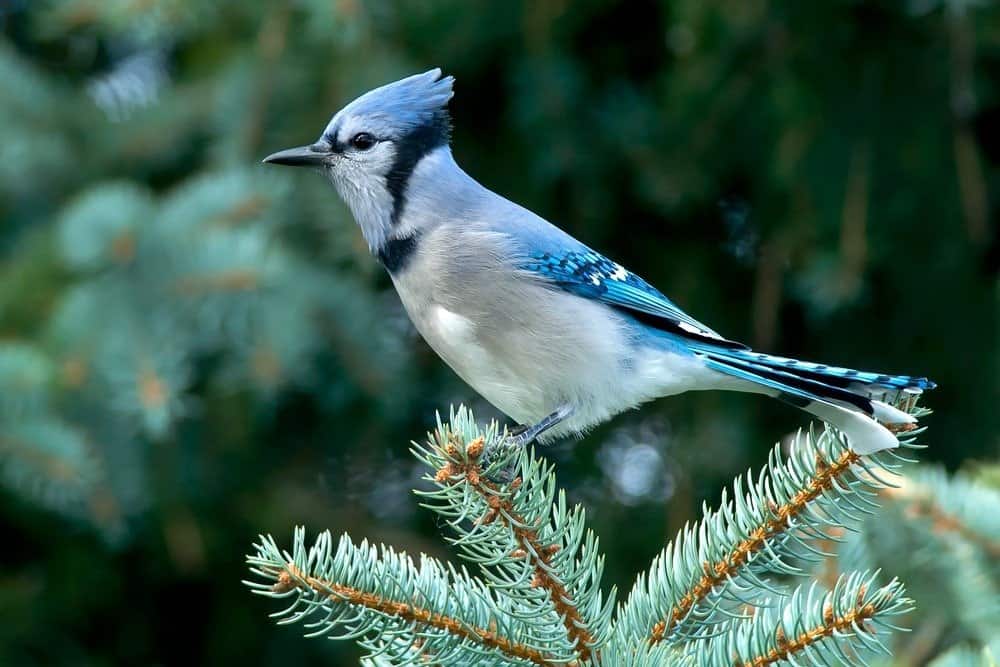
Blue jays are prolific in the east, including Alabama. You can find them in towns, parks, woods, and gardens.
©Paul Reeves Photography/Shutterstock.com
Habitat and Range: The blue jay is an unmistakable sight in the east. They live year-round in Alabama and the rest of the Eastern United States. You will see them in familiar places, like towns, gardens, parks, groves, and pine woods.
Coloring: Shades of sky blue, royal blue, black, and white mark their feathers.
Calls: They make a variety of sounds, including soft clicks, chucks, whirs, and clear whistled notes.
Diet and Foraging: These omnivores have a wide-ranging diet, including insects, plant matter, small rodents, frogs, baby birds, and carrion. They are frequent visitors to backyard feeders.
Backyard Tip: Cracked corn, suet, mealworms, and sunflower seeds are their favorite snacks!
Summary of 12 Blue Birds in Alabama
Here’s a recap of the dozen beautiful blue birds we looked at that can be found in Alabama.
| Number | Bird Species | Coloring | Residency |
|---|---|---|---|
| 1 | Cerulean Warbler | Sky blue, white, and black | Common migrant through Alabama |
| 2 | Blue Grosbeak | Vibrant blue, chestnut, silver, and black | Breeds in Alabama in spring and summer |
| 3 | Northern Parula | Bluish-gray, chestnut, yellow, white, and black | Breeds in Alabama in summer |
| 4 | Rock Pigeon | Mix of bluish-gray, green, purple, light gray, and white | Lives year-round in Alabama |
| 5 | Red-Breasted Nuthatch | Bluish-gray, white, black, and rusty red | Spends winter in Alabama |
| 6 | Indigo Bunting | Sky blue, royal blue, silver, and black | Breeds in Alabama in summer and spring |
| 7 | Tree Swallow | Bluish-green, white, and brownish black | Common migrant through Alabama |
| 8 | White-Breasted Nuthatch | Bluish-gray, white, black, and chestnut | Lives year-round in Alabama; not present in the far southern region near the coast |
| 9 | Common Grackle | Blue-green, bronze, and purple | Lives year-round in Alabama |
| 10 | Belted Kingfisher | Bluish-gray, white, and chestnut | Lives year-round in Alabama |
| 11 | Eastern Bluebird | Vibrant blue, white, and rusty red | Lives year-round in Alabama |
| 12 | Blue Jay | Sky blue, royal blue, black, and white | Lives year-round in Alabama |
The photo featured at the top of this post is © iStock.com/SteveByland
Sources
- Wikipedia, Available here: https://en.wikipedia.org/wiki/List_of_birds_of_Alabama
Thank you for reading! Have some feedback for us? Contact the AZ Animals editorial team.






